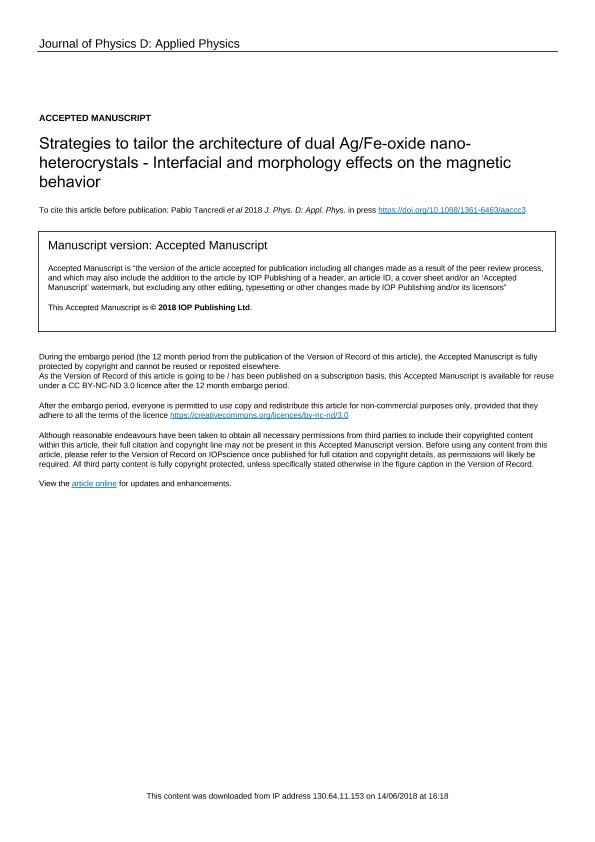Artículo
Strategies to tailor the architecture of dual Ag/Fe-oxide nano-heterocrystals—interfacial and morphology effects on the magnetic behavior
Tancredi Gentili, Pablo ; Moscoso Londoño, Oscar
; Moscoso Londoño, Oscar ; Rivas Rojas, Patricia Carolina
; Rivas Rojas, Patricia Carolina ; Wolff, U.; Socolovsky, Leandro Martín
; Wolff, U.; Socolovsky, Leandro Martín ; Knobel, M.; Muraca, D.
; Knobel, M.; Muraca, D.
 ; Moscoso Londoño, Oscar
; Moscoso Londoño, Oscar ; Rivas Rojas, Patricia Carolina
; Rivas Rojas, Patricia Carolina ; Wolff, U.; Socolovsky, Leandro Martín
; Wolff, U.; Socolovsky, Leandro Martín ; Knobel, M.; Muraca, D.
; Knobel, M.; Muraca, D.
Fecha de publicación:
06/2018
Editorial:
IOP Publishing
Revista:
Journal of Physics D: Applied Physics
ISSN:
0022-3727
Idioma:
Inglés
Tipo de recurso:
Artículo publicado
Clasificación temática:
Resumen
Bifunctional nanostructured architectures have shown appealing properties, since a single entity can combine the diverse properties of its individual constituents. Particularly, by growing Fe-oxide domains over Ag nanoparticles, the plasmonic and superparamagnetic properties can be combined in a single particle. Beyond the multifunctionality of this system, there are several properties that emerge from intrinsic factors, such as: interface and/or morphology. In this study, we present the synthesis protocols to obtain two sets of heterocrystals, each one with different morphology: dimer and flower-like. In addition, the magnetization behavior of these hybrid nano-heterocrystals is investigated and discussed. These nanomaterials were built by a seed assisted heterogeneous nucleation process, carried out in organic solvents of high boiling point, using the same batch of silver nanoparticles with a mean size of 6 nm as seeds, and tuning the electron-donor capacity of the reaction environment at the thermal decomposition of the iron precursor. Ag/Fe3O4 heterocrystals with dimer and flower-like morphologies were obtained. The synthesis protocols for generating these types of nanomaterials are discussed step-by-step. Structural and morphological properties were determined by transmission electron microscopy, x-ray diffraction and x-ray absorption fine structure. DC magnetization results suggest that the silver/magnetite coupling generates an increase of the blocking temperature in comparison to those obtained from pure magnetite. This behavior could be linked to a possible increase in the magnetic anisotropy produced by an additional disorder at the Ag–Fe3O4 interface. The higher interface area of the Ag/Fe3O4 heterocrystals with flower-like architecture leads to a higher blocking temperature and a stronger magnetic anisotropy. These results are supported by AC susceptibility data.
Archivos asociados
Licencia
Identificadores
Colecciones
Articulos(INTECIN)
Articulos de INST.D/TEC.Y CS.DE LA ING."HILARIO FERNANDEZ LONG"
Articulos de INST.D/TEC.Y CS.DE LA ING."HILARIO FERNANDEZ LONG"
Articulos(SEDE CENTRAL)
Articulos de SEDE CENTRAL
Articulos de SEDE CENTRAL
Citación
Tancredi Gentili, Pablo; Moscoso Londoño, Oscar; Rivas Rojas, Patricia Carolina; Wolff, U.; Socolovsky, Leandro Martín; et al.; Strategies to tailor the architecture of dual Ag/Fe-oxide nano-heterocrystals—interfacial and morphology effects on the magnetic behavior; IOP Publishing; Journal of Physics D: Applied Physics; 51; 29; 6-2018; 1-11
Compartir
Altmétricas



